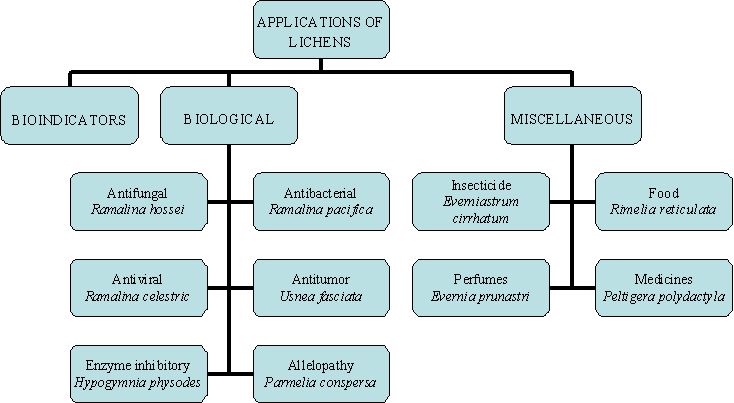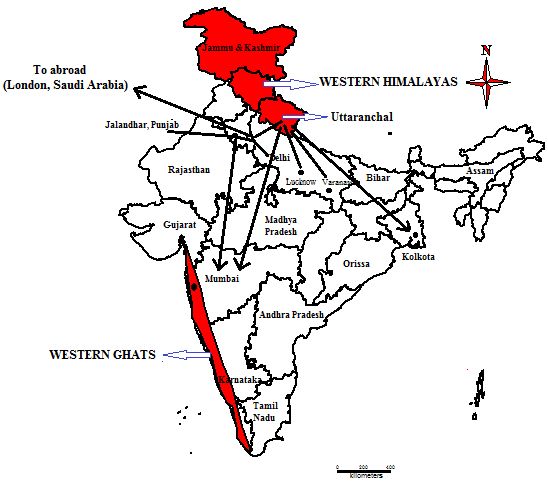 |
Sudarshan P. Bhat, Sumesh N. Dudani, M. D. Subhash Chandran and T. V. Ramachandra |
 |
LICHENS OF WESTERN GHATS
The Western Ghats of the Indian peninsula constitute one of the 34 global biodiversity hotspots along with Sri Lanka, on account of exceptional levels of plant endemism and by serious levels of habitat loss (Conservation International, 2005). The rugged range of hills stretching for about 1600 km along the west coast from south of Gujarat to the end of the peninsula (lat. 8° and 21° N and long. 73° and 78° E), is interrupted only by a 30 km break in Kerala, the Palghat Gap (Radhakrishna, 2001). Covering a geographical area of about 160,000 km2, the Western Ghats have an average height of 900 m, with several cliffs rising over 1000 m. The Nilgiri Plateau to the north and Anamalais to the south of the Palghat Gap exceed 2000 m in many places. Towards the eastern side the Ghats merge with the Deccan Plateau which gradually slopes towards the Bay of Bengal. The complex geography, wide variations in annual rainfall from 1000-6000 mm, and altitudinal decrease in temperature, coupled with anthropogenic factors, have produced a variety of vegetation types in the Western Ghats. The flora of Western Ghats comprises about 12,000 species ranging from unicellular cyanobacteria to angiosperms (Rao et al, 2005). The ecological niches in Western Ghats resemble islands so far as the distribution of endemic species is concerned (Nayar, 1996). The Ghats mountain range runs through different states of south-western India such as Gujarat, Maharashtra, Goa, Karnataka, Tamil Nadu, Kerala and covers various types of vegetation including evergreen, tropical deciduous, scrub, montane, subtropical temperate forests and grasslands. Although the higher plant flora and fauna of various ecosystems have been studied in great detail since European colonization in India, the lower groups of plants including pteridophytes, bryophytes, lichens, fungi and algae have not received the desired attention.
It is estimated that there are about 2040 species of lichens present in India (Awasthi, 2000). Western Ghats contain around 1096 lichen species belonging to 188 genera and 50 families. It harbors almost 47% of the total lichens in India, the highest for any lichenogeographical region in the country. Out of these 257 species are endemic to Western Ghats. Among different states Tamil Nadu have the highest number of lichens with 736 species followed by Karnataka, Kerala and Maharashtra with 455, 391 and 184 species respectively. The lichen flora of WG is dominated by microlichens (leprose and crustose forms) with 719 taxa (>64%). Among macrolichens foliose forms are represented by 324 taxa (including squmulose forms) and fruticose by 71. Parmeliaceae with 137 species belonging to 22 genera is the dominant family in the Western Ghats while Graphis is the dominant genus with 49 species (Nayaka, 2006). Western ghats has the maximum number of Pyrenocarpous (perithecia bearing) lichens (200) followed by Graphidaceous (125) and Thelotremataceous lichens (65).
The distribution of lichens as in other cryptogams is largely influenced by the microclimatic factors of the particular region. In the case of Western Ghats, the four major ecological factors that produce several microclimatic niches for the growth of lichens are substrate, vegetation, climate and altitude. The Western Ghats provide a wide range of substrates for the growth of lichens and hence, out of the total lichens found here, 953 are corticolous, 230 are saxicolous, 73 are terricolous, 56 are follicolous and 22 are muscicolous. Out of the 56 foliicolous lichens that are found in WG 48 are obligate leaf inhabiting and reported mainly from Nilgiri and Palni Hills (Pinakiyo & Singh, 2004). The optimum growth of lichen diversity in WG is found to between 1000 – 2400 m (Singh et al, 2004). Wide variation in the rainfall pattern and the complex topography of the region is responsible for a wide range of vegetation types in the Western Ghats and the lichen communities in each vegetation type differs to a great extent.
Lichenological investigations in India (Adapted from Nayaka & Upreti, 2006)
[Source: http://wgbis.ces.iisc.ernet.in/biodiversity/sahyadri_enews/newsletter/issue16/main_index.htm]
Lichens of India are being studied since 1753 AD. Linnaeus mentioned the occurrence of Lichen fuciformis (L.) DC. (Rocella montagnei Bél.) from India, in his masterpiece ‘Species Plantarum'. Eric Acharius (1810, 1814) the father of Lichenology describes lichens in his classical works ‘Lichenographia Universalis' and ‘Synopsis Methodica Lichenum'. There after the Indian lichens have been described by various lichenologists. Based on the 10 dominant families, 10 largest genera and other interesting features of lichen communities Singh & Sinha (1997) divided India in to eight lichenogeographic regions. Among them according to recent observation undoubtedly WG records the highest number lichen taxa (1096 spp.) followed by Eastern Himalayas (850 spp., Bajarbarua et al 2002) and Western Himalayas (~800 spp. unpbulished).
Bélanger (1838) initiated the study of lichens in the Western Ghats and described a total of 40 taxa from Pondicherry and Coromandel Coast of which six were new to science. Montagne (1842), Stirton (1876, 1879), Hue (1898, 1899, 1900a,b, 1901), Jatta (1902, 1905, 1911), Smith (1926), Choisy (1931), Santesson (1952), Moreau and Moreau (1952) were the important European lichenologists who studied lichens of WGs. Awasthi (1965) and Singh (1964) have compiled lichens described by various researchers till 1960s including that of WGs.
Quraishi (1928) and Chopra (1934) were the pioneer lichenologists in India who studied the Himalayan lichens. Dr. D.D. Awasthi, ‘Father of Indian Lichenology', started the study of lichens in a systematic way. His work on lichens of WGs was first published in 1957 (Awasthi, 1957), which reported new species, like Parmelia (Hypogymnia) pseudobitteriana (from Kodaikanal). The school of lichenology at Lucknow University contributed a lot to the lichens of Nilgiri and Palni Hills (Singh 1984). The lichenological investigation in WGs was strengthened during 1960's with the setting up of the school of lichenology at Agarkar Research Institute (‘Maharashtra Association for Cultivation of Science'), Pune. Lichenology laboratory of National Botanical Research Institute, Lucknow and Botanical Survey of India have compiled vast information on the lichens of WGs. Singh (1980) consolidated the lichenological investigation between 1966-1977. Upreti (1992, 1995, and 1997) and Upreti and Nayaka (2000, 2003) updated the developments in Indian lichenology.
Catalogue of the lichens from India, Nepal, Pakistan and Ceylon (Awasthi, 1965) lists around 250 taxa of WGs lichens. 225 taxa were added to the lichens of WGs during 1966-1977 (Singh, 1980). Patwardhan (1983), and Singh and Sinha (1997) estimation, shows 800 lichen species in WGs. Kumar and Stephen (1997a) in their attempt to consolidate information have listed 315 and 771 lichen taxa (Kumar and Stephen 1999), mainly based on macro and microlichen keys of Awasthi (1988,1991).
APPLICATIONS OF LICHENS
The lichens have diversified extensively during the last 600 years (Hawksworth & Hill, 1984) and occur in over more than 10% of the terrestrial surface (Praveen Kumar et al, 2010). Humans have exploited lichens for several purposes among which most important use has been for dyeing textiles (Praveen Kumar et al, 2010). Besides dyeing, lichens have been used extensively in medicines and cosmetics. Lichen substances exhibit diversity of biological effects-antimicrobial, anti-inflammatory, analgesic, antipyretic, antiproliferative and cytotoxic activities (Boustie & Grube, 2005). However relatively few lichen substances have been screened in detail for their biological activity and therapeutic potential, due principally to difficulties in obtaining them in quantities and purities sufficient for structural elucidation and pharmacological testing (Praveen Kumar et al, 2010). The different applications of lichens can be summarized as below:

Fig.2 – Different applications of lichens
Humans have been exploiting lichens and their substances for various purposes since long time. The lichens have found their stand as important part of traditional medicine, dyeing agents, food, bioindicators, etc. According to the concept given by Upreti et al, (2005), the lichens have been the household items of Indians since ancient times. The Himachal Pradesh and Uttaranchal hills are the major areas for lichen collection in India while in the central Indian region of Madhya Pradesh and certain localities of Western Ghats, few ethnic groups collect these plants (Upreti et al, 2005). However, the over exploitation and excessive collection of economically important lichen species has grown to be a major threat to the existing lichen flora.

Fig.3 – Lichen trading centres in India and their commercial supply to different cities
Lichens and lichen products have been used in traditional medicines for centuries and still hold considerable interest as alternative treatments in various parts of the world (Praveen Kumar et al, 2010). In various systems of medicine across the world including the Indian system, lichen species are said to effectively cure dyspepsia, bleeding piles, bronchitis, scabies, stomach disorders, and many disorders of blood and heart (Saklani & Upreti, 1992; Lal & Upreti, 1995; Negi & Kreem, 1996). Lichen substances exhibit a great diversity of biological effects, including antimicrobial, anti-inflammatory, analgesic, antipyretic, and anti-proliferative and cytotoxic activities, and there has been a growing interest in the pharmaceutical properties of compound derived from lichens (Boustie & Grube, 2005). In India, species of Parmelia are used extensively in traditional medicines and are also being collected extensively (Kumar & Upreti, 2001). Although many natural lichens and cultured lichens have been screened for their biological activities and several novel compounds have been isolated and identified, lichens have been essentially ignored by the modern pharmaceutical industry because of their slow growth in nature (Yamamoto et al., 1998; Lauterwerwein et al., 1995). Industrial-scale harvests are neither ecologically sensible nor sustainable and, for many species, are not feasible (Miao et al., 2001).
Cetraria islandica rates first as lichen food for humans. It is gathered commercially in the Scandinavian countries and in Iceland and sold on the market as "Iceland Moss". Schneider says of this "moss": "Inhabitants of Iceland, Norway and Sweden mix this with various cereals and mashed potatoes from which uncommonly healthful bread was prepared" (George, 1947). Bryoria fremontiiwas the most widely used edible lichen in North America a famine food for many groups, and a delicacy for some. The lichen was soaked to leach out any bitter principles, cooked over steaming rocks dried and cut into compact loaves (Hale, 1983). In Japan the foliose rock type’s umbilicaria are collected in mountain areas and eaten in salads or even deep fried in fat (Hale, 1983). The lichens have been household items of Indians since ancient times as medicines and in various cultural events. The common condiments used in food dishes called ‘Garam Masala', ‘Meat Masala', ‘Sambar Masala' also contains lichen powder or whole plants as a major ingredient. Parmotrema tinctorum is used as spice and flavoring agent (Upreti et.al, 2003).
Lichens are important as a food source for reindeer and caribou in the tundra and subarctic forests. The reindeer mosses (Cladinas, Cladonias, and Cetrarias) are most commonly grazed by these animals. Sheep in Libya graze on Aspilicia esculenta in the desert. (Hale, 1983). Some of the lichens, including species of Umbilicaria and Usnea, are well known to serve as a staple diet for the Alaskan reindeer and the Himalayan musk deer (Negi, 2003).
Lichens have been used as a source of dyestuffs since classical Greek times. Roccella, a fruticose lichen is a primary source of purple dye. Ochrolechia, Parmotrema tinctorum which contain simple depsides are soaked in a solution of ammonia to extract a deep purple principle called orchil (Hawksworth and Hill, 1984). Lichens are also used in preparation of perfumes and cosmetics. Pseudevernia furfuracea (Tree moss)and Evernia prunastri (oak moss)are widely used in the manufacture of perfumes (Huneck, 1999).
Lichens have evolved efficient mechanisms for accumulating nutrients from the environment in which they live. They adsorb metal ions such as Ca2+ via an ion exchange mechanism and can trap tiny particles of rock, soil or any other heavy metal pollutants within their structure. This ability of lichens can be efficiently used for monitoring the pollution levels and chemical analysis of lichen samples can be used to determine the extent and type of pollutant emissions around a particular industrial installation (Negi, 2003). Thus lichens are considered as Bioindicators of environmental pollution. Many studies have stressed the possibility of using lichens as biomonitors of air quality. Hypogymnia physodes is one of the most suitable bioindicators in the study of bioaccumulation of trace elements in view of its high tolerance capacities (Jeran et al, 1996). Pyxine cocoes a foliose, most common epiphytic lichen species was found to be an excellent accumulator of different metals, as the elements such as Fe, Al, Zn, Ni and Cr tend to concentrate in noticeable amounts in this lichen (Rajesh et al, 2010). Shukla et al, (2009) observed the Accumulation of Polycyclic Aromatic hydrocarbons in the lichens of Garhwal Himalaya. Studies of Saxena et al, (2007) showed that crustose lichen Arthopyrenia nidulans and foliose lichen Phaeophyscia orbicularis have high capacity to accumulate heavy metals. Krishna et.al (2007)observed high amount of Mercury in lichens near a Thermometer factory in Kodaikanal. The substrate having high arsenic ranges also exhibit higher ranges of arsenic on lichens growing on them. Higher concentration of Arsenic was found in lichens growing on site having mining activities (Bajpai et al, 2009).
THREATS AND CONSERVATION
Lichens are very sensitive organisms and their response to the environmental changes may include changes in their diversity, abundance, morphology, physiology, accumulation of pollutants etc. The main threats that apply to biodiversity in general are also true for lichens, e.g. habitat degradation and loss, habitat fragmentation, overexploitation, air pollution, and climate change (Christoph & Werth, 2009). The fast pace of urbanization and industrialization in recent years is responsible for a perceptible decline in the vast ranges of forest areas in different parts of the world. The various activities such as agriculture, mineral extraction, tourism, hydroelectric and road building projects leads to the rapid extinction of lichens. Factors such as Environmental pollution, urbanization, forest fires and deforestation have been identified as the major threats to the lichen flora (Negi, 2003). Overgrazing by animals like reindeer also leads to extinction of lichens. There has been a sharp increase for the demand of herbal products, spices, condiments, non-timber forest products, etc. from the forests and hence, the unregulated harvesting of lichens has become a serious hazard to biodiversity in Himalayas and Western Ghats (Upreti et al, 2005). Lichens are slow growing organisms and thus, if once removed from their habitat, they will take several years to reestablish. Air pollution is yet another major threat to the lichens as they are sensitive to different levels of pollution. Loss of the lichen diversity and change in their community due to air pollution, urbanization and changed climate was clearly witnessed in Bangalore (Nayaka et al, 2003) and Kolkata cities (Upreti et al, 2005).
The present estimate of the lichen populations in Western Ghats is based on the survey of some limited localities and hence, this estimate is very poor. The Western Ghats possess many protected areas in form of National Parks, Wildlife Sanctuaries, Biosphere Reserves and Reserve Forests. Conservation of their habitat is very important to prevent the extinction of lichens. It can be done by developing strategies for insitu and exsitu conservation. The overexploitation of natural resources should be reduced and conservation areas must be prioritized. It is important to create awareness among peoples about the importance and conservation of lichens. Declaring lichen-rich areas as ‘lichen sanctuaries’, enriching the existing botanical gardens with lichens and creating lichen gardens would be effective methods to conserve them in their natural habitats. Such sanctuaries and gardens would be unique in the world; apart from conservation, they also serve as educational and recreational sites (Upreti and Nayaka, 2008). The illegal harvesting of lichens for commercial purposes should be prohibited. The developmental projects affecting the protected areas should be reviewed before it is implemented. More research activities should be encouraged on lichens.
| Back | Next |
